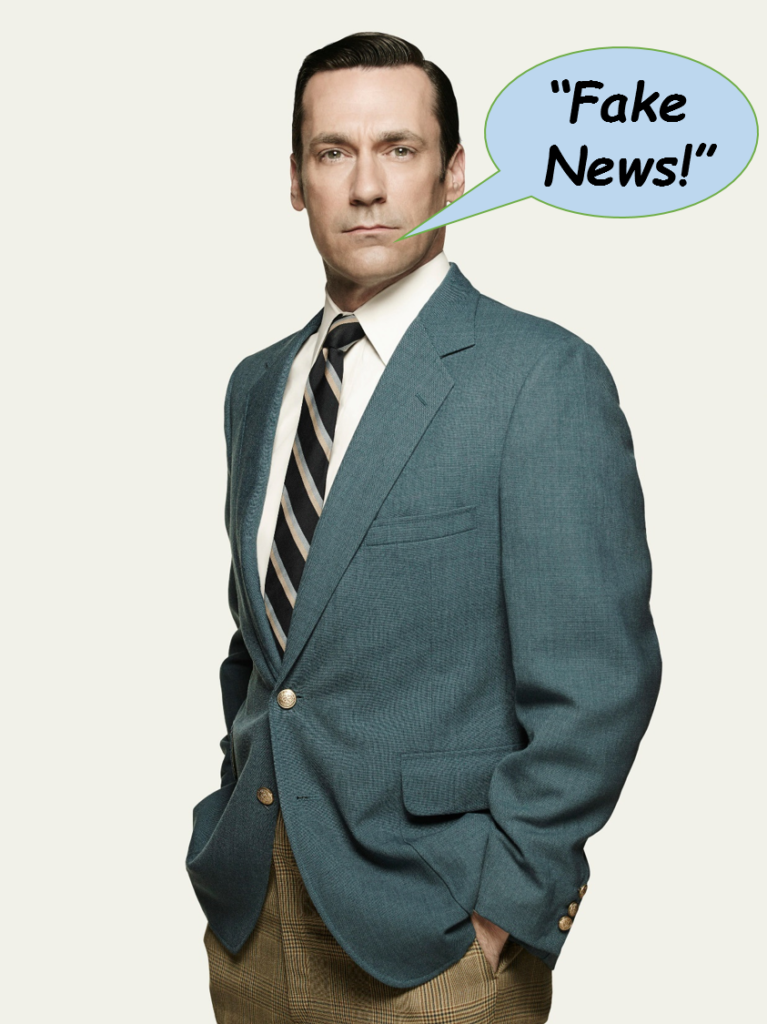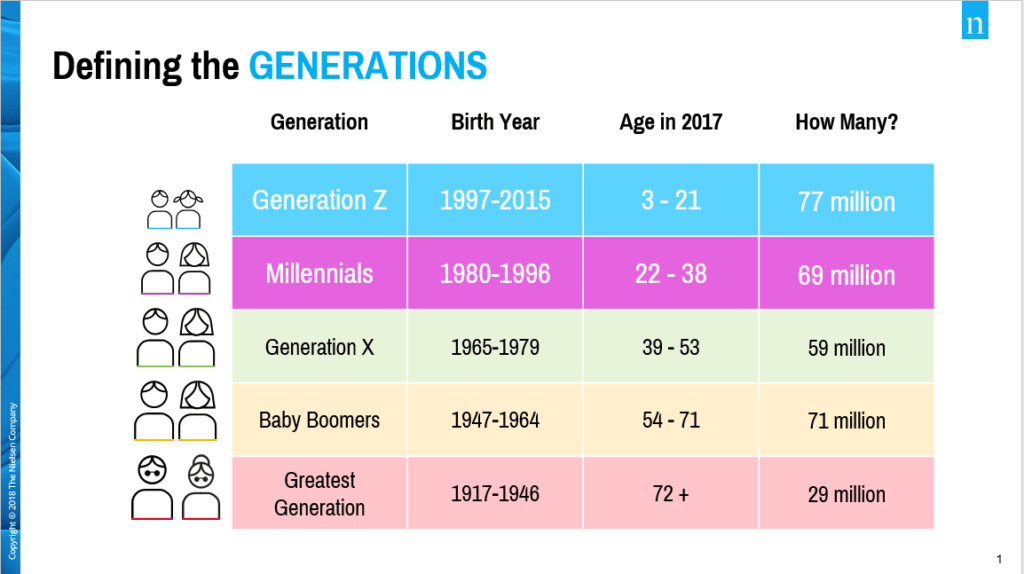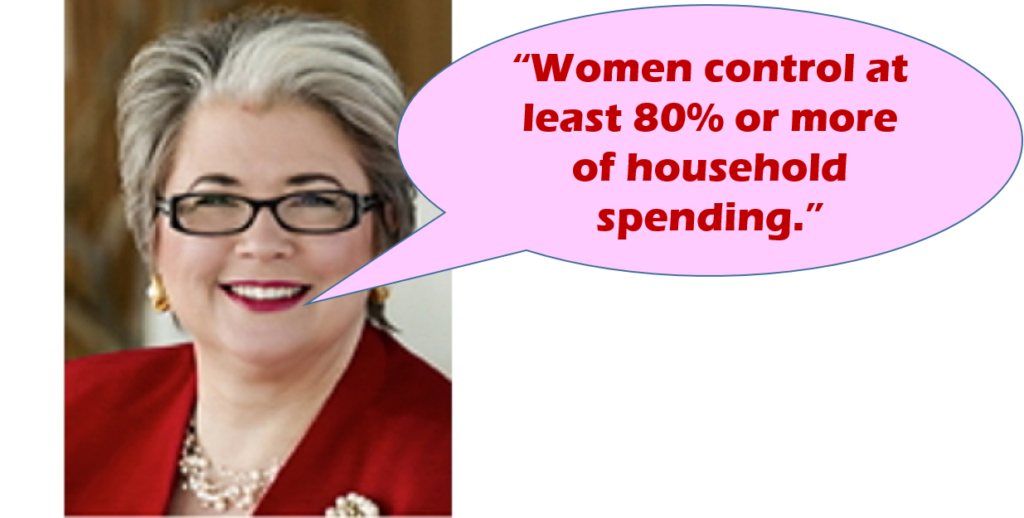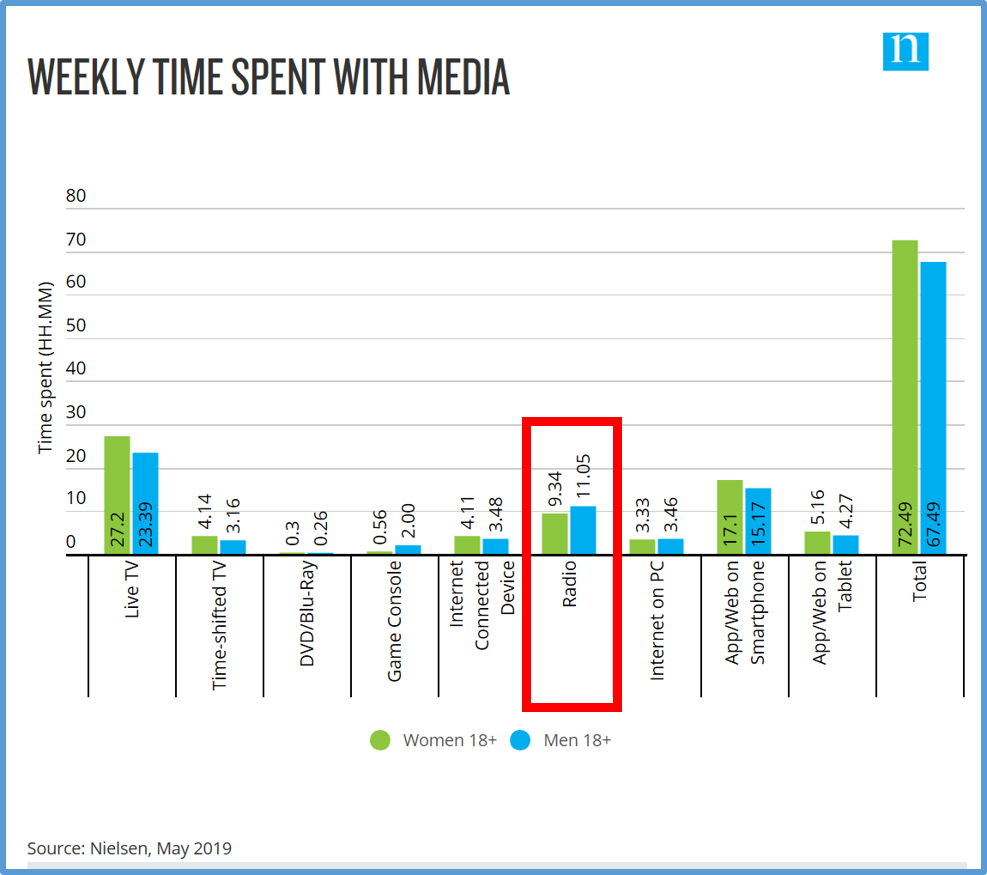
Paul Jacobs is a proud member of the broadcast radio sales community. In fact, he has represented hundreds of radio stations and the companies that own them to advertisers – the movers and shakers on Madison Avenue, as well as car dealers and retailers in small, unrated markets.
And along the way, he’s heard it all – objections, roadblocks, speed bumps, along with excuses, rationalizations, misconceptions, exaggerations, and uninformed thinking.
In today’s post, Paul pulls back the covers and analyzes advertiser thinking. And along the way, he discovered no shortage of “Fake News” – about radio, its listeners, and its media competitors. – FJ
When I was an undergrad at Michigan State back in the 1970’s, my goal was to go into radio as my career. Like so many young people, I thought my future was on the air and I was destined to become a big star. That was, of course, until I actually listened to an aircheck from a shift I did at a campus radio station.
At that point, I knew if I wanted to work in radio, I’d better focus on my true talent: sales.
Herb Tarlek jokes aside, sales is a noble profession, especially in radio. Great sales marketing talent has always been at a premium in radio, and that’s especially true today. It’s one thing to sell transactionally, using just the numbers. And we know programmatic is the next extension, a way to buy radio without all the people getting in the way.
But true sales marketing is about problem-solving and connecting the dots – helping clients, advertisers, and business owners reach their desired audience with as much engagement and efficiency as possible. When it works, it’s an amazing process that gets results.
Throughout my career – especially after joining Fred at Jacobs Media in the early 90’s, I have made literally thousands of sales calls and presentations to advertisers of all stripes, ranging from small retailers to mega-agencies. And while they all have individual needs and characteristics, there is one common thread:
Their propensity to buy into stereotypes, while missing trends that appear obvious to everyone but them.
More often than not, these clients want to almost always take the safe way out by following their industry echo chamber or their own demographic stereotypes.
And they are incredibly gullible to “Fake News” about what works – and what doesn’t – reinforcing their deep-seated beliefs about listener demographics, formats, and radio itself.
Some of my best years were selling Rock radio, then known as AOR – Album Oriented Rock. When I first joined the legendary sales staff at WRIF, and later on at KZEW (Dallas), our target was Baby Boomers. Of course, this burgeoning generation was 18-34 years-old back then, and because advertisers were so focused on older, more traditional audiences, it wasn’t always easy to get their attention.
On the one hand, the best and most effective way to reach those Boomers was with Rock radio, but on the other, many advertisers couldn’t bring themselves to support music generated by long-haired radicals like the Beatles, Led Zeppelin, and Jimi Hendrix. It was my first indication that, despite empirical data, many advertisers were wearing blinders.
generated by long-haired radicals like the Beatles, Led Zeppelin, and Jimi Hendrix. It was my first indication that, despite empirical data, many advertisers were wearing blinders.
Boomers were becoming an economic force that has endured to the present – they became the largest and wealthiest generation in history. And in short order, advertisers and brands began to aim their products at this massive group of young people.
But back then, the perception was that Rock stations had what was known as a “black T-shirt audience” – not the kind of people who were getting married, starting families, buying homes and cars. Amazing, highly successful stations – including the Loop, WRIF, BCN, and KISW – weren’t getting their fair share of media buys because of these wrong-headed beliefs about the audience.
Sadly and not surprisingly, the same thing is happening today with Millennials and GenZ, as stereotyping keeps otherwise smart marketers from taking advantage of the next major generational wave hitting our country. As Nielsen reminds us, Boomers were a force unique to American demographics: 71 million of us.
But the combination of Millennials (69 million) and GenZ (77 million) creates an economic shift that cannot be ignored, even if you are a traditional advertiser.

Advertisers, marketers, and buyers often create their own characteristics about consumers and the generations they represent as an excuse not to buy them. If Baby Boomers were hippie stoners, today’s youth market are privileged slackers – under-motivated, living in their parents’ basements, playing video games, and saddled with college debt. Who in their right mind would target this group? They have no money and a suspect future.
As is usually the case, the stereotypes are wrong. The upper end of the Millennial generation is pushing 40. Many have families, and are spending significant dollars on housing, transportation, travel, and entertainment. The Bureau of Labor Statistics reports the median income of Millennials is $56,000, and remember, that figure includes many still in college or just getting their careers underway.
According to Realtor.com, Millennials took out 46% of all new mortgages by the end of Q3 this year, while Generation X represented only 35% and Baby Boomers represented only 17% – both are falling. Without a doubt, Gen Y has come a long way from living with the ‘rents, but too many advertisers continue to ignore, overlook, or undervalue them. The blue line below tells an important story:

And that brings us to one of the most egregious habits of advertisers: ignoring men. OK, so maybe I take this a little personally, but as someone who’s made his career selling Rock formats with more than a simple majority of male listeners, it’s astonishing that smart, savvy mass marketers will totally ignore a demo that makes up roughly half the population, or just buy one Rock or Sports station in a 6-station buy and reach they conclusion they’ve got men covered.
This situation reached an apex a generation ago when we felt compelled to create and launch our “Marketing To Men” research study. Our clients were witnessing a migration of businesses to female demos and since there was a paucity of research, we fielded our own. Using the databases of Rock and Sports stations, we found that when it came to household purchases over $400, the decision-making process was virtually equal between males and females.
At the time, “Marketing To Men” received ample coverage – in AdWeek, Bloomberg Businessweek, Yahoo! Finance, and Forbes, as well as the San Francisco Business Times, the Atlanta Business Chronicle, and the Boston Business Journal, along with hundreds of other publications and websites. It also made the rounds in eMarketer’s Digital Intelligence and MediaPost’s Marketing Daily.
The venerable 4As checked out “Marketing To Men,” as did Harmelin Media, McCann Erickson, Digitas, and Leo Burnett. We heard from everyone from HSBC to the Cartoon Network to ESPN to the U.S. Postal Service. The study hit its goal – it made a lot of noise and raised a lot of eyebrows.
Yet, when we talked to advertisers then (and still today), most will insist that 80% of purchasing decisions for the household are made by women.
After we published our study, we were contacted by a reporter from The Wall Street Journal, Carl Bialik. After reading our study, he decided to get to the root of the issue.  Where did this data point – that women control the lion’s share of household spending – come from?
Where did this data point – that women control the lion’s share of household spending – come from?
And what he discovered was the person credited with championing the 80% figure was Marti Barletta, a consultant for female-targeted companies. On her website, Barletta liberally uses quotes that position her as “The World’s Foremost Expert On Today’s Mightiest Market – Women.”
Her expertise apparently goes well beyond the guru level, all the way to the highest religious references:
“The High Priestess of Marketing to Women” (Huffington Post)
“The Chief Rabbi of Sheconomy” (Time)
But when Bialik was asked for the source of her 80% data point, Barletta admitted there was never any sourcing for that figure: “It is sadly one of those rule-of-thumb numbers that everyone in the industry uses.”
Yes, “Fake News.”
In other words, billions of advertising dollars have being targeted on a benchmark that came out of thin air. A myth. An apparition.
Brilliant.
In our work with Rock, Classic Rock, and Alternative clients, I’ve spent the better part of two decades sharing the truth about the value of Millennials and men. And it’s been challenging because many of these myths have hardened into facts.
I was reminded of this when I came across a new study from Nielsen called, “Attention Marketers: US Women Are Eager To Hear From You.” The study compared consumption of all media between men and women, and in most cases, women spend more of their time consuming media than men.
Except for radio, where men listen 11.05 hours/week compared to 9.34 hours/week for women.

A no-brainer, right?
Not so fast. Later in the article, Nielsen leaves us with this telling quote about women:
“And, knowing that (women) drive 70%-80% of consumer purchases their total media consumption is more than simply an open door for any company looking to help them lighten their daily load and compete for their business.”
There it is again. The curse of Marti Barletta.
Now, Nielsen is a responsible data-driven company. So, a further look at their piece showed the 70%-80% claim was linked to another story. And just a click later, I discovered it was on the Bloomberg site in a section they call “diversity and inclusion.”
Written nearly two years ago, “Top 10 things everyone should know about women consumers,” the very first item on their punch list was this nugget:

There’s some good news here. Some advertisers are bucking the trend, becoming more aware that men matter. From single dads to guys sharing more of the load, brand marketers are viewing men with more respect – and attention. And they’re gearing creative toward all those men that have been systematically ignored when advertisers market household products – like diapers.
This recent ad for Pampers debuted this past Father’s Day. It features music icon, John Legend, and it’s not an isolated ad. More and more, men are getting attention from advertisers – just not on the radio.
https://www.youtube.com/watch?v=1RKNm8balSs
Old stereotypes die hard.
The reason “Fake News” becomes accepted fact is when misconceptions are repeated again and again – especially by credible sources.
Even when they’re absolute nonsense.
- For Radio, Will It Be Christmas In April (And Hopefully, May)? - April 21, 2025
- The Revolution Will Not Be Monetized - December 30, 2024
- What Kind Of Team Do You Want To Be? - October 4, 2024




Excellent piece, Paul. This information is very helpful. Most of my career has been spent with rock and sports stations and that, “80% of the buying decisions are made by women” mantra buyers use is a huge argument to battle. We know it’s wrong because of the great results marketers get from targeting men.
Appreciate it, Doug. It was a real shock to me when I first got into the business and had a hard time getting major advertisers like Chevrolet recognize the power of Baby Boomers. At that time, the Big 3 automakers thought they had control of the car market, and they stuck to their traditional buying models. So what happened? Toyota, Datsun (Nissan) and Honda came to the US and targeted us. Look at shares of car sales today – the seeds were planted while the agencies had their heads in the sand and were afraid of offending their clients by challenging their thinking.
Outstanding piece Paul, and spot on. May I take you on a call for my Classic Rocker the next time?!
Thanks!
Buck, thanks for the comment and of course I’ll go on a sales call with you – hire us!! Seriously, changing opinions takes time. Stations need to campaign for their audiences. As someone once said, “Opinions are like glaciers – slow to form and slower to melt.” But I’ve learned over time, if you’ve got a good case and make it consistently, minds will change.
Keep up the good fight.
Always selling.
It’s who I am.
It’s what I do.
ABC. But wasn’t you dad that taught you “everyone’s in sales”?
Nice piece Paul. And now the challenge is even greater as both clients and media buyers respond to their own behavior patterns, which seldom includes listening to much radio. So the discussion isn’t male/female – it’s how do we emotionally engage a new generation of buyers/clients who are much less likely to be consumers of our product? That’s the challenge.
And… greetings for a great holiday for both of you!
Thanks, Jackson. It’s even bigger than that – those decision-makers who declare things like “nobody listens to the radio anymore” or see what their kids are doing and state that’s what everyone does. We live in a complicated, nuanced world. Not all women make purchasing decisions – 50% or marriages end in divorce, so who’s buying groceries for all the single guys out there?
And . . . . the happiest of holidays to you and yours.
Thanks for the holiday greetings Paul. Back at ya…and all your team…
I agree with virtually everything you said here and it mirrors my experience. Worse to me than few acknowledging the value of 18-34s once upon a time, was when the rock audience had aged to become a major 25-54 force and were frozen out by format dictates. Katz radio did a piece that tried to dispel the stereotype with pictures some of its top execs with long hair/t-shirts, then another showing how they looked now (now back then if that makes sense). “Is this the AOR audience (old pics?)” “You bet it is! (new pics).” Did it work? Nah. Some deep background:
I repped a lot of rock stations that were top ranked 25-54 and weren’t allowed to be bought based on format restrictions. Virtually all of these dictates came from the agency – a couple of times when I approached the agency’s clients about this they were somewhere between dismayed and shocked. All they wanted to do was increase sales and to that end were format agnostic. There is also a real agency bias toward every client being upscale – including ones that clearly aren’t.
The solution to the fake news problem isn’t trying to change stereotypes at ad agencies. They’re baked in, including the belief that no one under 40 listens to radio anymore, ever. No ad campaign will ever change that, particularly the ones that focus on metrics like reach that aren’t in dispute that no one currently cares about or ever did.
The way to combat fake ad news is one client (not agency or buyer) at a time. By reaching out, learning their challenges and collaboratively developing a solution that offers an attractive potential ROI to both sides. In other words, good old-fashioned consultative sales.
Lurking behind this issue is the old, “radio needs to tell its story better” line. I disagree – radio needs to stop telling it’s story and realize that it’s job is to tell its customer’s stories. Do it, then radio can tell THAT story. And that will chip away at the fake news issue, one solved customer problem at a time.
Bob, for one of those rare moments, I have nothing to say. You’ve covered it perfectly.
Best to you and your family this holiday season.
Another home run
Thanks, Tom. I hope you are doing well.
Hi Paul (and Fred). Just catching up on recent Jacob’s Blog Posts. This one, including the responses from readers really hit home for me. Although I’ve been in the Urban space only for the last 20 years – running the Radio One stations in Raleigh – I, like you, started out selling AOR in Cleveland in the late 70s. It was a tough sell back then for all of the reasons you cite. Today, I think agencies de-emphasize formats and stations that may have fallen down the ranker 25-54 but are very strong 50-64. This would be the case with the UAC format and today’s Classic Rock and Classic Hits stations. These stations reach people really well that are still in the workforce (not many people fully retire before age 65), likely making more money than ever before, now empty nesters meaning they have more spendable income than ever before. They own homes, eat out at expensive restaurants often, travel etc aren’t saddled with student debt – you get the idea. But agencies and buying services want to load up on stations that show up near the top A 25-54 but “skew” under 45. The “Wiz Kids” in Corp Marketing positions and in Media Depts don’t get it, to their own peril and their company’s bottom lines, that ignoring 50+ is not sound strategy
Gary, not surprisingly, we’re on the same page here. Radio’s ability to target just about everyone is under-valued. And that’s precisely why so many stations gravitate to the 30-year age cell that’s “easy.” It has done our industry a disservice. Thanks for chiming in.
Wow. As a trained journalist I’m embarrassed to admit it took an adman to remind me of the most basic element of journalism: Get the facts straight! Happy Holidays, Paul!
Regina, well, as a trained adman I strike to adopt the qualities of journalists! Sometimes when you see the same thing over and over again across decades, it’s like stating the obvious. But it is constantly amazing to me how consistently “off” advertisers have been with their stereotypes.
Have a wonderful holiday season and here’s to a great 2020!